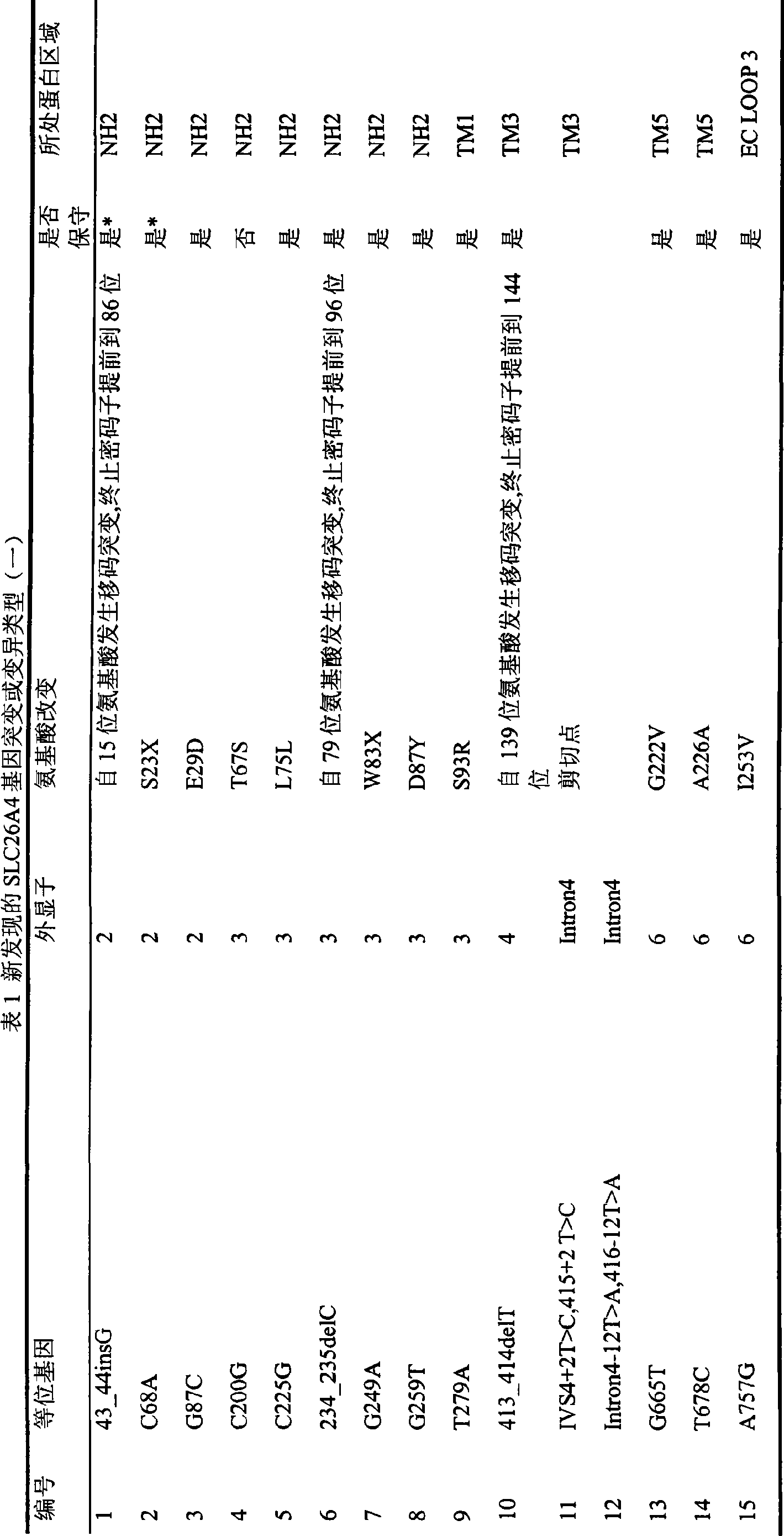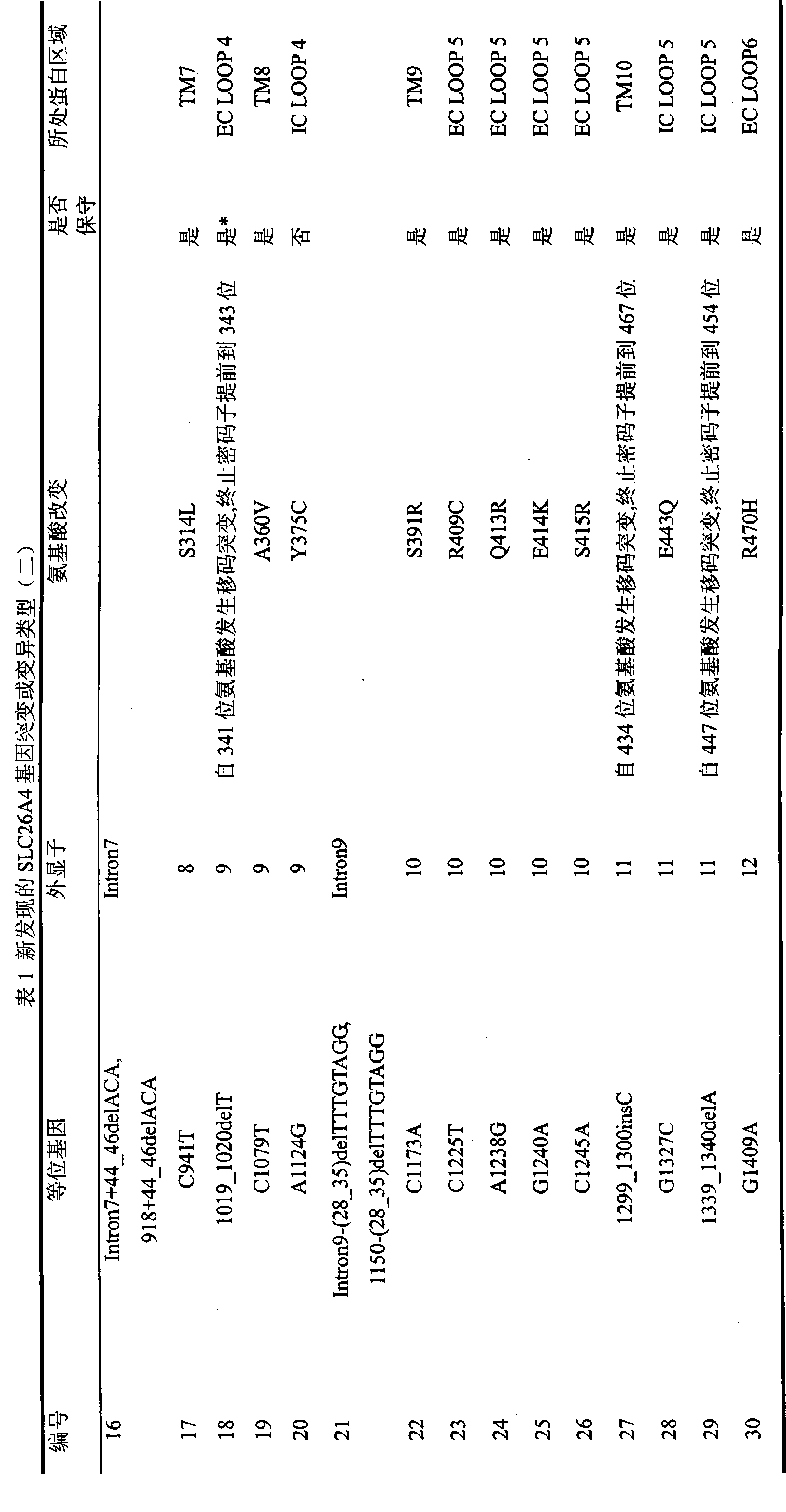Mutation type and mutation frequency of hereditary hearing loss gene SLC26A4 in Chinese crowd and usage of mutation type
A technology of hereditary deafness and mutation type, applied in the field of tr, can solve problems such as protein structure and function impact
- Summary
- Abstract
- Description
- Claims
- Application Information
AI Technical Summary
Problems solved by technology
Method used
Image
Examples
Embodiment 1
[0079] The inventor first reported in China that 3 cases of patients with sporadic large vestibular aqueducts were screened for SLC26A4 gene, and one case was found to be heterozygous for the G316X mutation, and two cases were homozygous for IVS7-2A>G, and then detected in two large vestibular aqueduct families The mutation of SLC26A4 gene preliminarily confirmed the correlation between SLC26A4 gene and large vestibular aqueduct.
[0080] In this study, according to our previous findings in 38 cases of large vestibular aqueduct from 35 families, the mutation of SLC26A4 gene IVS7-2A>G is a high-frequency mutation in Chinese large vestibular aqueduct syndrome, accounting for 10% of the total number of mutations. This mutation can be found in 63.5%, 71.9% of patients with large vestibular aqueduct, and 1% of normal people carry this heterozygous mutation.
[0081] Therefore, for this specific mutation, we designed a series of diagnostic screening methods and tools. Through this s...
Embodiment 2
[0083]In order to understand the mutation status of SLC26A4 gene in Chinese severe-very severe deafness population and its relationship with deafness, on the basis of the above research, we launched a nationwide screening of SLC26A4 gene hotspot mutation regions, and detected single heterozygous Carriers of combined mutations are further screened and sequenced to find additional mutations that may exist. The screening method includes designing multiple PCR primers or kits according to conventional methods based on the aforementioned possible 86 mutation types of the SLC26A4 gene. PCR or multiplex PCR testing or sequencing. The subjects of the study were patients with bilateral severe-profound deafness, selected from Beijing, Shanghai, Mudanjiang of Heilongjiang Province, Jilin of Jilin Province, Datong of Shanxi Province, Anyang of Henan Province, Gaobeidian and Zhuozhou of Hebei Province, Foshan of Guangdong Province, Liuzhou of Guangxi Zhuang Autonomous Region , Fuzhou in Fu...
Embodiment 3
[0087] According to the above research results, we designed three sets of qualitative gene chips, namely
[0088] Chipset A: Contains two mutation sites, IVS7-2A>G and A2168G;
[0089] Chipset B: Contains 13 mutation sites including IVS7-2A>G, A2168G, A1174T, C1229T, T2027A, IVS15+5G>A, G589A, A1238G, T1826G, C281T, G1226A, C1336T, 1548insC;
[0090] Chipset C: Contains IVS7-2A>G, A2168G, A1174T, C1229T, T2027A, IVS15+5G>A, G589A, A1238G, T1826G, C281T, G1226A, C1336T, 1548insC, G1975C, G259T, T279A, G6659T, C110319T, C118del , C1225T, G1595T, 1299_1300insC, C2162T, 1339_1340delA, C1343A, 1687_1693insA, C2167G and other 27 mutation sites.
[0091] Three sets of gene chips were used to detect 58 patients with vestibular aqueduct enlargement (a total of 95 mutant alleles were detected by sequencing of the SLC26A4 gene coding region), and the results are as follows:
[0092] chip
Group sample
number allele
factor The detected SLC26A4
number of mutant...
PUM
 Login to View More
Login to View More Abstract
Description
Claims
Application Information
 Login to View More
Login to View More - R&D
- Intellectual Property
- Life Sciences
- Materials
- Tech Scout
- Unparalleled Data Quality
- Higher Quality Content
- 60% Fewer Hallucinations
Browse by: Latest US Patents, China's latest patents, Technical Efficacy Thesaurus, Application Domain, Technology Topic, Popular Technical Reports.
© 2025 PatSnap. All rights reserved.Legal|Privacy policy|Modern Slavery Act Transparency Statement|Sitemap|About US| Contact US: help@patsnap.com



